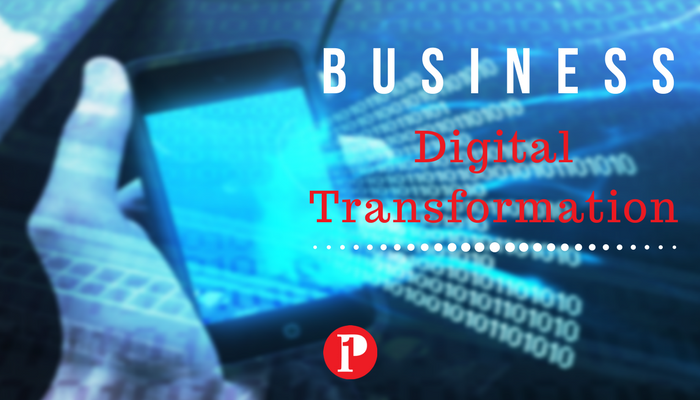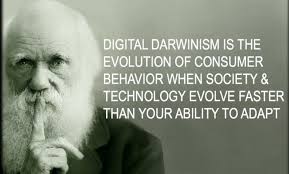
What is this digital transformation people keep talking about?
How does that affect me and my business? Career?
With every new opportunity for businesses to evolve, there are significant challenges. How companies address them will determine their growth and progress through the Six Stages.
Each year, in addition to assessing key opportunities, executives share the top challenges they currently face in their digital transformation efforts.
In the 2016 research, the top business challenge was understanding evolving customer behavior.
Executives said that they struggled most with understanding new connected customers’ behaviors, which subsequently was the top driver for digital transformation efforts: “evolving customer behaviors
and preferences.”
ALL COMPANIES ARE BECOMING TECHNOLOGY COMPANIES
Corporate innovation is vital to uncovering new means and opportunities to better compete.
There are many current trends across business and technology landscapes that point to digital transformation’s shift away from marketing and toward the IT organization. As digital transformation matures within a business, the investment, implementation, and management of new technologies is destined for CIOs and IT. At the same time, businesses face a wave of disruptive technologies fated for implementation in every part of a company’s technology ecosystem. These disruptive technologies — AR, VR, AI, machine learning, big data, blockchain, IoT, and conversational commerce — require technical ownership and skillsets to design and implement new solutions.
Faster and faster, all types of businesses are becoming technology companies. In the inaugural 2014 digital transformation report, Adam Brotman, Starbucks’ executive vice president of global retail operations and partner digital engagement, shared that Starbucks “acts like a consumer technology company” when it comes to its digital strategy. He advised other companies to do the same.
Fast-forward to July 2017, when Starbucks’ Chief Strategy Officer Matt Ryan discussed the scope of its ever-broadening technology strategy as part of the company’s post-earnings call.
“This fundamental modernization of our technology stack will replace legacy rewards and ordering functionality with the new, scalable, cloud-based platform for rewards and ordering, improved customer data organization, and tighter integration with store-based operating systems, including inventory and production management,” Ryan said.
As digital transformation matures, many more companies are exploring innovative technology as an enabler for new customer- and employee-driven initiatives. Domino’s Pizza also cites its current trajectory and success by becoming a technology company that also makes and delivers pizza around the world. Domino’s Pizza Chief Executive Officer (CEO) Patrick Doyle shared lessons about making radical change to traditional business models at a 2016 CEO summit titled How to Transform a Legacy Company Into a Technology-Enabled, Nimble, Category-Disrupting Machine.
Domino’s prioritizes investments in technology and expertise to emphasize innovation in pizza delivery. As a result, it hired 400 software and analytics professionals to explore application improvements and new delivery capabilities, such as drones, autonomous cars, and mobile ovens.
DIGITAL TRANSFORMATION IS AN EFFORT TO AVERT “UH OH”
The remaining drivers should not go unnoticed, as they tell the complex story of how businesses are reacting to digital Darwinism, the survival of the most adaptable in the evolution of technology and its impact on markets and people’s behaviors.

Most businesses just react to market shifts and trends, making them early in their digital transformation. However, 36.9% surveyed seem prescient because they treat digital transformation as a proactive investment for adapting to market disruption before it’s too late.
Getting ahead of digital transformation is a promising trend. Most companies react to change in one of two ways, either ahead of trends (“a ha”) or in response to the effects of change (“uh oh”).
In what may be a sign of “uh oh” moving to the forefront, 16.7% of survey participants cited a decline in business performance as their reason for pursuing digital transformation.
Digital transformation is a game-changer. Like every market disruption, it requires companies to shift perspectives and invest in modern proficiencies and talent. Yet, unfortunately, only 20.3% of businesses view “the lack of expertise, literacy, and understanding of digital trends” as a driver for digital transformation.
While customer experience is often cited as a focal point for initial digital transformation, the same digital factors affecting customers also influence employees. This year, the updated survey was to track the growing importance of employees in digital transformation. In 2017 “employee behaviors and preferences” shares the top spot as a primary factor driving digital transformation. Expect employee engagement and experience (EX) to grow in importance in 2018 and 2019.
KEY DRIVERS OF DIGITAL TRANSFORMATION
By design, CIOs/CTOs manage enterprise-wide technology initiatives. In comparison, CMOs historically have focused on marketing, sales, and customer experience. These executive roles are evolving. No role, either independently or collectively, can successfully design and implement digital transformation strategies based on legacy or silo-based perspectives, risk-averse decision-making, or internally-focused initiatives.
This year, 64.6% of businesses interviewed are prioritizing “evolving customer behaviors and references” as a key driver for digital transformation. This is up from 55% in 2016.
In 2014, we consistently found advanced companies centered their efforts on customer engagement and experience. Doing so helped them concentrate on initiatives and investments that drove business value, demonstrated impact, and introduced opportunities to collaborate across a company’s departmental silos.
Competitive pressures and new markets rank as the second and third drivers of digital transformation. These rankings reveal the urgency within companies to optimize operations and innovate.
Companies surveyed in 2017 are simultaneously experiencing increased competitive pressure (54.2%) and growth opportunities in new markets (46%).
TOP CHALLENGES FOR DIGITAL TRANSFORMATION
With every new opportunity for businesses to evolve, there are significant challenges. How companies address them will determine their growth and progress through the Six Stages.
Each year, in addition to assessing key opportunities, we ask executives to share the top challenges they currently face in their digital transformation efforts.
In the 2016 research, the top business challenge was understanding evolving customer behavior. Executives said that they struggled most with understanding new connected customers’ behaviors, which subsequently was the top driver for digital transformation efforts: “evolving customer behaviors and preferences.”
So what was the most surprising result from the digital transformation study?
“What surprised us most is just how far behind companies are in their digital transformation efforts,” Solis said. “In fact, when executives benchmark the status of their efforts against our maturity model, ‘The 6 Stages of Digital Transformation‘, they consistently peg themselves further along than they really are.”
There is a shift in power when it comes to digital transformation.

Lack of digital literacy and expertise anchors digital transformation to the past.
Not everyone understands digital. Businesses and their change agents still face monumental challenges to achieve successful digital transformation. It’s difficult for many executives and colleagues to “get” and, therefore, prioritize digital initiatives ahead of personal agendas. Our 2017 study exposes this issue, which will become increasingly visible during the next two years. “Low digital literacy or expertise among colleagues and leadership” leads the list of challenges at 31.4%.
Many companies are not equipped to swiftly adapt to disruption.
Limited digital literacy and expertise will greatly restrain transformation, which requires a dedicated employee engagement program and signals the importance of Human Resources departments in future trends.
Though employee engagement is a critical challenge, it sits atop a long list of equally difficult challenges.
LOOKING FORWARD
Companies must look beyond digital technologies and drive business innovation with a human- entered approach. People (customers and employees) and their preferences, behaviors, and expectations continue evolving when disruptive technologies impact markets. Additionally, companies must explore current and future technology trends to become technology companies in their own right.
The State of Digital Transformation — 2017 highlights the early evolution through the Six Stages maturity model. These times demand urgency and acceleration of their efforts. Innovation and change management are critical partners for digital transformation initiatives. The combination introduces new business and operation models to expedite and escalate change across the Six Stages.
SOURCE: Altimeter Group | Brian Solis
About Blair

Blair Evan Ball is a Social Media Coach and founder of Prepare1, a company that works with businesses, individuals and non-profits. He is a former executive with a Fortune 50 company, and his national division did $1Billion+ in sales annually.
Blair has written three e-books: Facebook for Business Made Easy, Facebook Pages for Business Made Easy, and WordPress Blog Setup Made Easy.
Blair also educates, trains entrepreneurs and business professionals how to amplify their brand, increase revenues, and raise more funds.
![[Study] How Will Businesses Change Their Social Media Activities 5 Golden Rules for Sharing on Social Media](https://www.prepare1.com/wp-content/uploads/2014/03/COACH-logohat-162x300.jpg) The Race is ON! | PREPARE | Get into the Game and WIN!
The Race is ON! | PREPARE | Get into the Game and WIN!










Comments on this entry are closed.